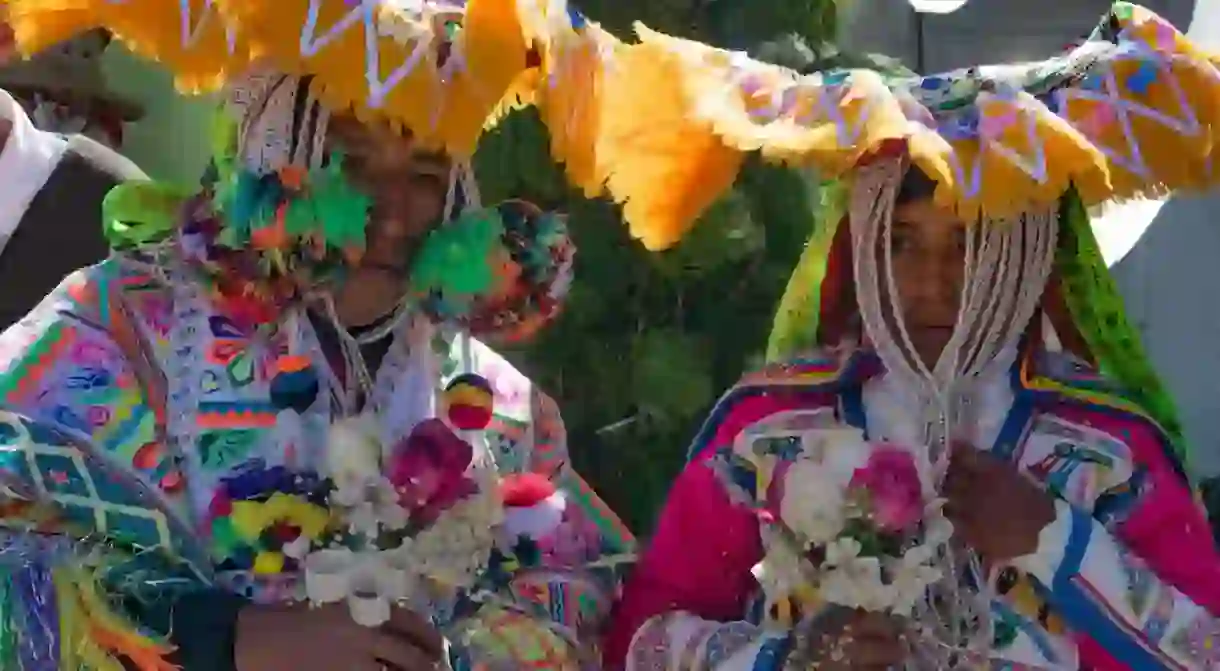The Dos and Don’ts of Being a Guest at an Andean Wedding Ceremony

Attending an Andean marriage is a special privilege for travelers visiting Peru. From wearing ponchos and giant skirts to remembering the all-important Inca Kola, here’s everything you need to know about being an excellent guest at a traditional Andean wedding.
Do…
Wear a traditional dress
As well as celebrating love and unity, Andean weddings are an opportunity to honor hundreds of years of tradition and culture, and Andean wedding attire is a huge part of this. Women traditionally wear layered sequined skirts, colorful lampshade-like hats and embroidered jackets, while men don colorful ponchos and wooly hats. To fit in as much as possible (and just because it’s great fun), leave your suit or dress at home and opt for the Andean style instead. Chances are that if you’re staying with an Andean family, they won’t let you go in anything else anyway.

Wrap up warm
Whatever you’re wearing, one thing’s for sure: you’ll need to put on some warm clothes. In Andean culture, nature is deemed the single most sacred thing on Earth. For this reason, most weddings will take part outside in the presence of Pachamama (Mother Earth) and the Apus (sacred mountain spirits). While the scenery is bound to be stunning, the high altitudes of between 13,123 and 19,685 feet (4,000-6,000 meters) – as well as little to no cover – mean it can get pretty chilly, especially if you’re standing around in the gift queue for a few hours.

Accept the chicha welcome drink
It’s custom at an Andean wedding to be met by a line of men and women serving a light yellowish liquid from huge metal cauldrons. They’re serving cups of home-made chicha, an alcoholic drink made from fermented corn that dates back to the time of the Incas. This beverage is a symbol of hospitality, so even if you’re not all that keen on the drink, it’s polite to accept it and drink it there and then with your fellow guests.

Take a gift for the bride and groom
One of the main events of an Andean wedding is the gift ceremony. Once the bride and groom have eaten a feast of potatoes, alpaca meat and corn, they’ll stand at their top table with a red ribbon tied around their necks. This red ribbon runs 328 feet (100 meters) into the crowd, where wedding guests will line up (some of them for hours on end) and wait to give their gifts to the newlywed couple. The immediate family will bring large homeware items, such as wardrobes, mattresses and stoves (the idea is to provide the couple with a comfortable start to family life). However, you don’t need to bring half a kitchen with you; money, fizzy drinks (Inca Kola being the firm favorite) and bags of corn are popular gift items from friends and neighbors.

Expect a gift in return
When it’s (finally!) your turn to give your gifts to the newlywed couple, they’ll show their appreciation by hugging you and exchanging a few words of thanks. Then, it’s custom for the bride to give a large handful of popped or boiled corn in return, which women usually store in the top layer of their pollera skirt to eat later. If you haven’t got a skirt on, then just accept the gift with both of your hands and a big smile.

Don’t…
Stay away from the dance floor
Once the gift ceremony is over, it’s time to hit the dance floor. You’ll notice that the women take the lead on this, forming a big circle in front of the live band and moving around slowly with bouncy twists and turns, a style of dance unique to the Andean region. Eventually, the men from the bride’s family will join in and start dancing with women from the groom’s side in pairs, a tradition that marks the union of the two families. You’ll likely be asked to join the circle. If this happens (even if you don’t have a clue how to ‘Andean’ dance), be brave and join in!

Be shy with guests
For some guests, it may be the first time they’ve seen foreign faces at a wedding, so don’t be alarmed if you turn a few heads when you walk in. If they’re a little shy approaching you, make the first move and start up a conversation. This provides a rare opportunity to interact and make a connection with a new culture and people, so be sure to take it!

Take photos without permission
While many guests will happily pose for the camera, be aware that not everyone is comfortable being photographed. As mentioned above, not everyone will be used to having outsiders at a family event. Therefore, it’s best to break the ice with some conversation first, and of course, always ask before you take the shot.

Turn down the second (or third) plate of food
Here’s the thing with Andean weddings: the food keeps on coming. Tradition has it that both the bride’s and groom’s families stay up all night to prepare an endless feast for more than 1,500 guests. Over a couple of hours, a human production line will form to dish out a constant stream of quinoa soup, alpaca meat, potatoes, rice, corn and cuy (guinea pig). Like many cultures, turning down food – especially if great effort and care have gone into preparing it – is impolite, so do your best to leave a clean plate.














